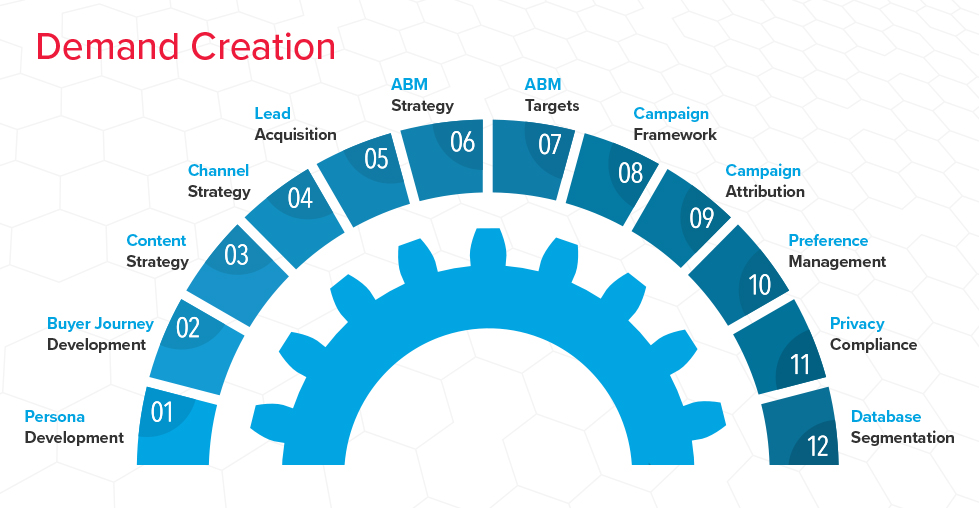
One of the most common questions I get when speaking to B2B marketing and sales executives is how can they best align marketing and sales?
Over the last 20 years since I have been in the B2B space, the alignment of these two groups has seemed to elude many despite their best attempts. Many organizations I work with still struggle to find a common ground whereby marketing and sales can work in a cohesive fashion in order to increase revenue.
This challenge of alignment was one of the many topics we discussed early last year as we developed The D3 Methodology™. We spent time discussing these two departments, their roles in demand generation and revenue creation, and the many issues we see that keeps them from this all-too-important alignment.
After much debate we agreed that rather than focus on aligning marketing and sales, it is far more productive and valuable to have marketing and sales integrate.
Perhaps you are reading this and thinking the difference is semantics. I would disagree and do believe it is vital that marketing and sales leaders integrate their departments rather than just align. To further make my point, I want to take a minute and contrast the meaning of the words.
According to Merriam-Webster, align is defined as follows:
1 : to bring into line or alignment
// aligned the books on the shelf
2 : to array on the side of or against a party or cause
// He aligned himself with the protesters.
While alignment can be a positive, by definition it simply means a common way of thinking. In today’s world of B2B demand generation, this is not enough as has been proven by the many organizations that still struggle.
The definition of integration is much more powerful in its meaning and is defined as (bold and underlines are mine):
1 : the act or process or an instance of integrating: such as
a : incorporation as equals into society or an organization of individuals of different groups (such as races)
b : coordination of mental processes into a normal effective personality or with the environment
Integration, by its very definition, speaks to equality and synchronized coordination around a process or operation. It is this coordination between marketing and sales that is needed in our complex B2B buying environments of today if organizations are going to create revenue from their demand generation investments.
So, how can this happen? How can an organization move from what may be current disorganization or even mere alignment between these two groups to an integrated, synchronized machine that is generating revenue?
Let me suggest three areas of focus that will help you integrate your marketing and sales teams.
- Integrate by Adopting a Common View of Your Buyers & Customers
One of the foundational disciplines of The D3 Methodology is Demand Creation. You will see by the image below that foundational to demand creation is the identification of your buyers via the creation of buyer personas and documenting the buyer’s path to purchase:

While many organizations have developed personas, they fail to deliver value due to the way they were created. That is to say that marketing took the initiative to create these personas with little to no input from sales or even customers. This results in an insular, one-sided view of the customer that does not accurately represent the true customers, their needs, and their buying objectives. If this describes how your business has developed personas and journey maps, it is no wonder that sales has objected to using these descriptors.
When looking to define who your key buyers and customers are, it is necessary that sales play an active role in the development. They have a unique perspective and key insights given their relationship to the customer. To not have this is to have an ill-informed picture of your buyers and the path they take to purchase.
- Integrate by Having a Common Process
A number of years ago I sat with the head of marketing operations for a technology company as we reviewed the Lead Management Framework he and his team had developed. It was an impressive model and it was clear that they had worked hard to develop their scoring, Demand Funnel, and routing rules. During the review, I asked him how sales responded to this and was assured that there was alignment.
My next meeting was with the global head of sales. When I asked him about the lead management processes that had been established, he stated, “I’m aware of them, but those were done with no sales input so they do not apply.”
He was not trying to be an obstacle to demand generation, but as I questioned further it became apparent that the marketing-defined process did not take what sales needed into consideration. The head of sales was not in a position to change for change sake, so he discarded the process in order to keep his sales team moving forward and the two sides struggled to integrate as a result.
When defining your Lead Management Framework, it is vital that both marketing and sales integrate around a common process. This means that both departments need to have a stake and voice in the construction to ensure demand generation efficiency and effectiveness.
- Integrate through Shared Business Objectives
On more than one occasion I have been in the presence of a marketer as they rolled their eyes and bemoaned the fact that “sales is so coin-operated.”
To be clear, sales should be coin- (and customer-) operated, so I have never really understood the complaint. Additionally, marketing would do well to adopt this way of thinking. One of the best ways an organization will succeed in integrating their marketing and sales teams is by owning shared business objectives. And one of these objectives will always be revenue.
By sharing business objectives, establishing common Key Performance Indicators (KPIs) to measure progress towards those objectives, and clearly defining the roles that each department will play, integration will become more the norm than the exception. If these shared business goals are not defined, integration will be simply wishful thinking.
As we begin a new year, now is the time for corporate leaders to move beyond the idea of alignment and understand the importance of integrating their marketing and sales teams in order to create an always-on, sustainable revenue engine.

As Chief Strategy Officer, Carlos Hidalgo guides DemandGen’s enterprise clients on developing their strategy and initiatives for digital transformation, helping to make the complex world of digital marketing simple while driving revenue and achieving operational excellence. Carlos is widely recognized for his expertise in B2B change management strategies, marketing, sales, content development and demand generation, and has spent the past two decades helping enterprise marketing and sales leaders optimize their approach to demand generation for maximizing revenue growth.
The post Why Marketing & Sales Alignment Is Not Enough appeared first on DemandGen.


![The Importance of Marketing Technology in 2021 — and How to Ensure Your Stack Is Up to the Challenge [Guide]](https://content.cdntwrk.com/mediaproxy?url=https%3A%2F%2Fwww.demandgen.com%2Fwp-content%2Fuploads%2F2021%2F01%2Fmartech-2021_1_demandgen.jpg&size=1&version=1712702759&sig=bebc2787257205b9adb9eab757b541ba&default=hubs%2Ftilebg-blogs.jpg)




















